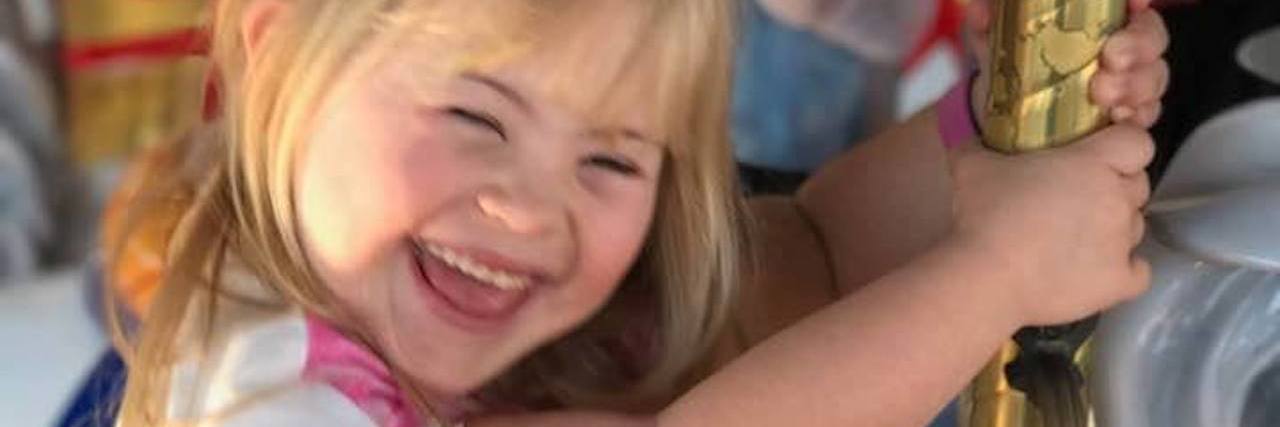From the moment we learned the baby I was carrying had Down syndrome and a heart defect, my husband and I were told of what she would not be able to do. Many were even quick to suggest I shouldn’t continue my pregnancy. My own doctor told me our baby would not have a high quality of life, that she might not be mobile or communicate well.
Years later, we are thankful for a thriving, healthy 7-year-old daughter with bright blue eyes and a contagious laugh. She just happens to have Down syndrome. That diagnosis does not define her, but we’ve had to work hard to ensure others don’t limit her.
Early on, we pegged our girl as “Limitless Lila.” We decided that if we loved, supported and challenged her, others’ limits would not become a reality.
Unfortunately, there have been may times when society, systems, schools and social norms haven’t supported that “limitless” ideal. Whether simply a quick assumption from a stranger or a label placed by a service provider, we’ve learned that being our child’s biggest cheerleader is a much bigger job than it might be if she were not labeled with a diagnosed disability. Most of our experiences with healthcare and service providers working with her have been nothing but positive. However, inclusion in childcare and education has not been as easy to attain.
In South Carolina, we are fortunate to have services and resources available to help Lila thrive from the very beginning. Early intervention, therapies (speech, occupational and physical), and recreation programs begin quickly — including healthcare coverage available to those with disabilities or qualifying conditions. Federal law requires states to provide education at age 3.
A fighter from the beginning, our daughter overcame several major surgeries in her earliest of days, culminating with open-heart surgery at 6 months. Early Intervention and those three therapies started immediately — each an hour a week.
After a great experience in an in-home daycare that our son also attended, and an inclusive church preschool experience when she was 2 years old, Lila began public school upon her 3rd birthday. Those four hour-long, weekly therapy sessions continued, as well as many doctor’s appointments most 3-year-olds thankfully do not see (cardiologist, endocrinologist, audiologist, ENT and more).
As the years have unfolded, we’ve discovered that no matter how limitless we may consider our daughter, getting others to think the same is not easy. Some embrace her. Some love her unconditionally. But at the same time, those people and others make assumptions based on her diagnosis and appearance — and that causes them to position her on a designated path.
That path has proven to be unacceptable for us and for Lila. We have used options and services to pursue an inclusive education for her. Those have not always worked to her benefit.
Now, thankfully, we have found a private school option that is allowing her to excel. The director and the full team use words such as “capable” and “potential” in our conversations, and they are fully committed to helping Lila become an independent member of their school community. They believe in her and want to see her succeed.
Sadly, this option is one that has only come with much extra effort to ensure we have the means to pay the tuition. What’s more disturbing, is that the ability to make this choice is not possible for many in our community, our city or our state. Many must rely on the professionals to guide their journey and have the best interest of their children at heart. But our systems and resources are not working to the true advantage of the children — like our daughter — that they were designed to help.
There’s a lot of research mentioned in conversations and IEP meetings with those serving our children. But the bottom line is that research supports inclusion, in every environment, from the earliest of days. Our children do not initially notice the differences as something bad or undesirable. We all have something unique or different about us. Those things are only learned as the adults leave curious questions unanswered, single children out or bring negative attention to those differences. Inclusion teaches acceptance and tolerance and an understanding of what makes us all unique.
Whenever you’re around a child or individual with different abilities, smile and greet them and their parents just as you would anyone else. When a child asks a question about someone’s wheelchair or differences, answer them factually. That makes differences be just differences, just as we all have different accents, hair and skin colors, clothing and more.
Choose to be a part of accepting everyone around you — different or not. In reality, when we look closely enough, we are all truly more alike than different anyway.

